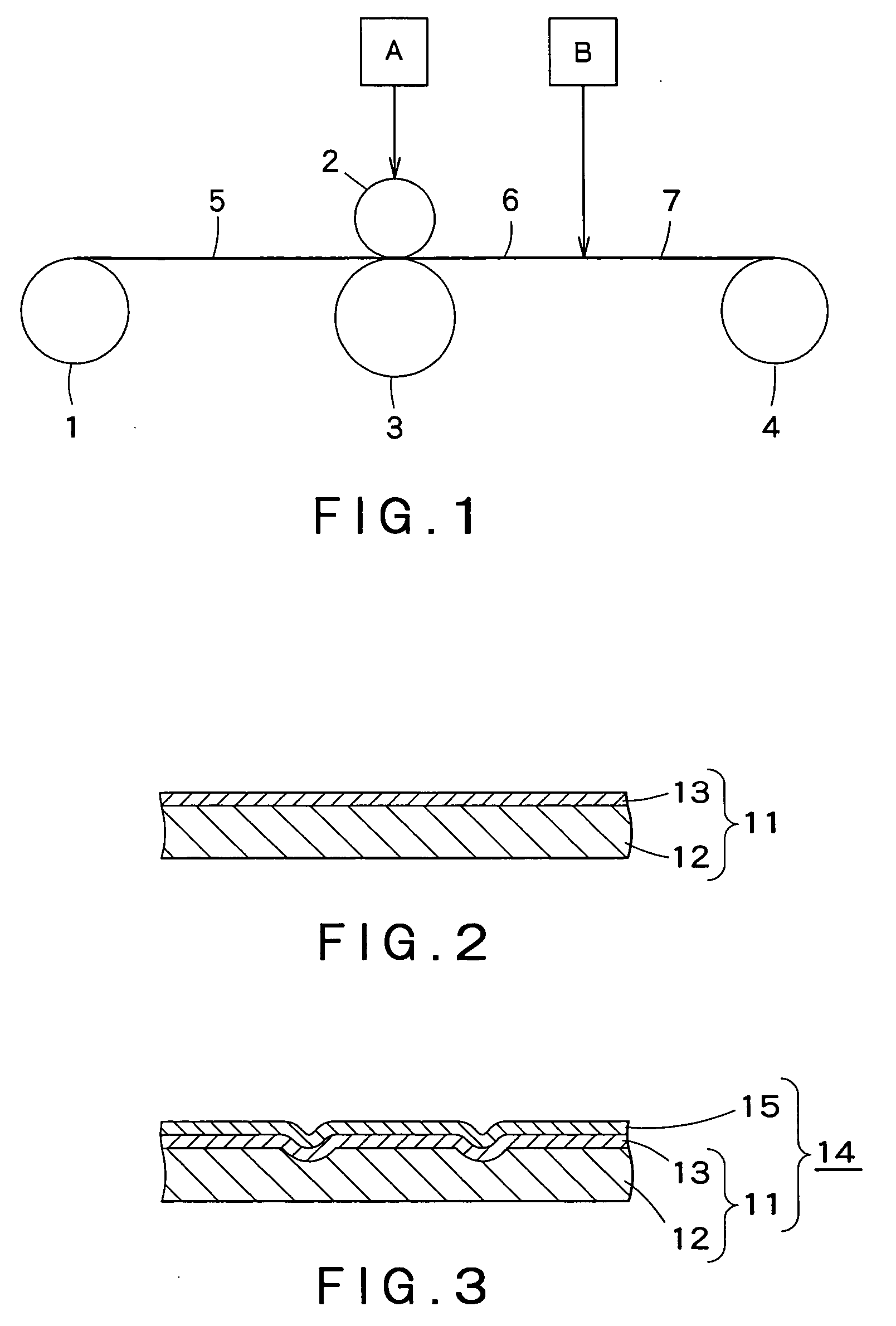Embossed release paper for synthetic leather production and support therefor, and synthetic leather using the release paper and process for producing the synthetic leather
a technology of embossing and release paper, which is applied in the direction of textiles and paper, synthetic resin layered products, layered product treatment, etc., can solve the problems of uneven gloss, low resistance, and difficulty in repeatedly using release paper, and achieve excellent releasability and embossability, the effect of producing synthetic leather and low cos
- Summary
- Abstract
- Description
- Claims
- Application Information
AI Technical Summary
Benefits of technology
Problems solved by technology
Method used
Image
Examples
first embodiment
Process for Producing Synthetic Leather in First Embodiment
[0142] The process for producing a synthetic leather in a first embodiment according to the present invention comprises using an embossed release paper for synthetic leather production, comprising at least paper as a support and an ionizing radiation cured film provided on the paper, the upper part of the cured film having been embossed. This release paper will be described later.
[0143] At the outset, a polyurethane resin composition is coated onto the embossed ionizing radiation cured film in the above release paper, and the coating is heat dried to form a skin layer. One-component polyurethane resin composition of polyester-type aromatic isocyanate urethane, polyether-type aromatic isocyanate urethane, polycarbonate-type aromatic urethane, polyester-type aliphatic isocyanate urethane, polyether-type aliphatic urethane, or polycarbonate-type aliphatic isocyanate urethane may be suitably used as the polyurethane resin compo...
second embodiment
Process for Producing Synthetic Leather in Second Embodiment
[0146] The process for producing a synthetic leather in a second embodiment according to the present invention comprises using the same release paper as described above. A polyurethane resin composition is coated onto the embossed ionizing radiation cured film in the above release paper, and the coating is heat dried to form a skin layer. This step is the same as the first embodiment, and, thus, an explanation thereof will be omitted.
[0147] Next, a wet intermediate layer is stacked onto the skin layer, and the skin layer and the wet intermediate layer are contact bonded to each other by a hot roll from the release paper side. An assembly comprising the skin layer contact bonded to the wet intermediate layer constitutes a synthetic leather. The contact bonding is carried out by a hot roll, and the temperature of the hot roll is preferably 110 to 190° C. The wet intermediate layer is formed by coating a solution of one-compo...
third embodiment
Process for Producing Synthetic Leather in Third Embodiment
[0149] The process for producing a synthetic leather in a third embodiment according to the present invention comprises using the same release paper as described above. A vinyl chloride resin composition is coated onto the embossed ionizing radiation cured film in the above release paper, and the coating is heat dried to form a skin layer. In the vinyl chloride resin composition, a homopolymer of vinyl chloride, or a polymer produced by copolymerizing a vinyl chloride monomer with a monomer such as vinyl acetate, ethylene, propylene, or maleic ester is usable. The vinyl chloride resin composition is prepared by adding a plasticizer such as a phthalic ester plasticizer or a fatty acid ester plasticizer to the above resin to prepare a paste and further adding an antioxidant, a stabilizer, a filler, a pigment and the like to the paste.
[0150] The coated vinyl chloride resin is generally solidified by heat drying at 200 to 250° ...
PUM
| Property | Measurement | Unit |
|---|---|---|
| softening point | aaaaa | aaaaa |
| heat resistance | aaaaa | aaaaa |
| temperature | aaaaa | aaaaa |
Abstract
Description
Claims
Application Information
 Login to View More
Login to View More - R&D
- Intellectual Property
- Life Sciences
- Materials
- Tech Scout
- Unparalleled Data Quality
- Higher Quality Content
- 60% Fewer Hallucinations
Browse by: Latest US Patents, China's latest patents, Technical Efficacy Thesaurus, Application Domain, Technology Topic, Popular Technical Reports.
© 2025 PatSnap. All rights reserved.Legal|Privacy policy|Modern Slavery Act Transparency Statement|Sitemap|About US| Contact US: help@patsnap.com


